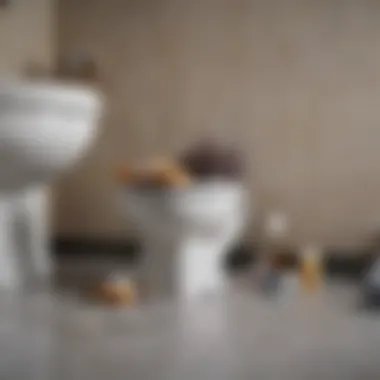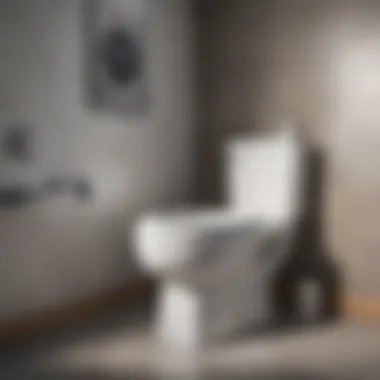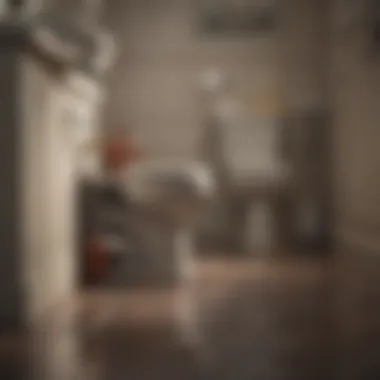Understanding and Addressing Toilet Clogs Effectively


Intro
Toilet clogs are a frequent headache for many homeowners. Understanding their cause and how to address them can prevent untimely disruption in daily routines. The immediate reaction when faced with a clog often involves frustration. However, knowledge can empower homeowners.
It helps to recognize what leads to a blocked toilet. In this guide, we will explore the key contributing factors, outline effective prevention strategies, and suggest when it might be wise to consult a professional plumber. By fostering awareness of these elements, one can maintain a smoother-running home environment.
Factors leading to toilet clogs might range from everyday mistakes, such as improper items flushed, to more complex plumbing issues. Addressing these can help you avoid unwanted inconveniences and expenses.
This guide aims to merge practical tips with useful insights, creating a resource for those seeking to mitigate plumbing problems and ensure their toilets function effectively.
Prelude to Toilet Clogs
Toilet clogs are a significant household issue that many people encounter at one point or another. Addressing this topic is essential as it touches on the practical aspects of home maintenance and daily comfort. Toilets are indispensable in every household, and the ease of access to a functioning toilet greatly contributes to a smooth daily routine. When clogs occur, they can lead to inconveniences that disrupt not only personal schedules but can also create unwarranted stress.
Understanding toilet clogs involves recognizing their causes, the ways to resolve them, and effective preventive measures. This narrative will help homeowners appreciate the importance of being proactive. Recognizing the signs of potential clogs early can save time, money, and frustration.
When toilet clogs happen, they require immediate attention. The situation can escalate from a simple interruption to severe plumbing issues if not managed correctly. Therefore, this section will lay the groundwork for further exploration of the problem and how to handle it.
Throughout this article, we will examine various aspects of toilet clogs, including their definitions, causes, and impacts on everyday life. The aim is to provide readers with insights that can improve their home maintenance routines, potentially leading to long-term solutions that prevent recurrent clogs. The understanding of the plumbing system also plays a crucial role in comprehending how to address clogs effectively.
Common Causes of Toilet Clogs
Understanding the common causes of toilet clogs is a crucial part of maintaining a functional plumbing system in any home. By identifying these causes, homeowners can take proactive measures to prevent clogs from occurring, thus minimizing plumbing headaches and inconveniences. Beyond mere frustration, frequent clogs can lead to more severe plumbing issues, costly repairs, and an unhealthy living environment. The following sections delve into specific causes of these obstructions in detail, providing insights for effective prevention.
Excessive Paper Use
Toilets typically rely on a delicate balance between water flow and waste disposal. An excess of toilet paper can disrupt this balance. While it is necessary for hygiene, using too much can lead to complications. The composition of toilet paper matters, too; some brands dissolve better than others. When thick layers of paper are flushed, they can easily create a blockage in the pipes. Homeowners should be mindful of how much paper they use, especially in homes with older plumbing systems.
Some tips for managing paper use include:
- Limit flushes: Instead of flushing large amounts at once, use smaller amounts.
- Choose the right product: Opt for thinner disintegrating toilet paper.
Clearing excessive paper use is a simple preventive measure that can pay off with fewer clogs.
Foreign Objects
Foreign objects are another significant contributor to toilet clogs. Children and pets are often the culprits, leading to accidental or intentional items being flushed. Typical items include toys, sanitary products, and even cleaning supplies. Not only can these objects cause immediate blockages, but they can also damage the toilet or plumbing system.
To address this issue, it is essential to regularly monitor who is using the toilet and what items may be left in its vicinity.
- Educate children: Teach kids the importance of keeping non-flushable items out of the toilet.
- Provide accessible waste bins: Ensure there are proper disposal options for items that should not be flushed.
These practices can significantly reduce the risk of foreign objects creating clogs.
Flushing Non-Flushables
In addition to foreign objects, many households encounter a significant problem with flushing non-flushable items. Products marketed as "flushable" may lead to misunderstandings about what can be disposed of in toilets. Items such as wipes, cotton balls, and dental floss often do not disintegrate effectively, leading to blockages in pipes.
To minimize this risk, homeowners should:
- Read labels carefully: Understand which items are genuinely flushable and adhere to those guidelines.
- Establish clear habits: Make it a household rule to dispose of non-flushable items in waste bins.
Being disciplined about flushing only appropriate items is key to preventing clogs.
Sewer Line Issues
Sometimes, the cause of toilet clogs is more severe and relates to problems in the sewer line. Factors such as tree root intrusions, grease buildup, and general wear and tear can obstruct the flow of waste. When sewer systems fail, toilets may back up, and this can lead to even more significant plumbing disasters.
Homeowners should look for signs indicating potential sewer line issues:


- Multiple drains clogging: If more than one toilet or drain is slow, this may signal a deeper issue.
- Strange noises: Gurgling sounds when flushing or draining can indicate an obstruction.
- Sewage odor: Unpleasant smells can suggest sewer line problems that need immediate attention.
Awareness of these issues and timely intervention can save time and money in the long run.
Preventive Measures
Toilet clogs can considerably disturb your day-to-day routines, thus preventive measures play a vital role in maintaining a smoothly running household. By understanding and implementing these strategies, you can significantly reduce the chances of encountering a clogged toilet. Proactive management not only saves time but also minimizes frustration. Knowing the importance of prevention emphasizes the idea that simple adjustments can have profound impacts on the plumbing system.
Educating Household Members
One of the most effective ways to prevent toilet clogs is through education. Every person in the household should be aware of what can and cannot be flushed down the toilet. Simple guidelines, such as using minimal toilet paper or avoiding the flushing of feminine products, can greatly enhance the longevity of your plumbing.
Educating young children can also be crucial. Children are often unaware of plumbing limitations. Take time to teach them about what constitutes a toilet clog. Such education fosters responsible usage and awareness.
In summary, greater awareness leads to more careful usage. This can greatly lessen the frequency of clogs and reduce the need for emergency plumbing interventions.
Regular Maintenance Practices
Regular maintenance practices are essential in ensuring that plumbing systems work efficiently. Such practices can greatly enhance the overall condition of your toilet. There are two components worth discussing: routine cleaning and regular inspections.
Routine Cleaning
Routine cleaning is the practice of maintaining the toilet’s condition through periodic cleaning sessions. Regular procedures, like scrubbing the toilet bowl and cleaning the surrounding areas, help prevent the buildup of debris. Over time, neglect can lead to mineral deposits, which contribute to toilet failure.
A key characteristic of routine cleaning is its simplicity. It doesn’t require specialized tools or knowledge. Homeowners can typically follow guidelines found online or in home improvement books.
The unique feature of routine cleaning is that it addresses surface-level issues which, if ignored, can lead to larger problems. Advantages include preventing unpleasant odors and maintaining a clean appearance, while its disadvantage is often related to the time commitment needed. However, the benefits generally outweigh any inconvenience involved.
Regular Inspections
Regular inspections can identify small issues before they evolve into major problems. This process involves checking for leaks, ensuring proper flushing, and monitoring the overall functionality of the toilet. Much like routine cleaning, inspections do not require professional knowledge but can be done by the homeowner, making it a beneficial practice.
The key characteristic of regular inspections is that they help maintain awareness of the plumbing system’s condition. By developing a strategy for inspection, such as checking once a month, homeowners can detect clogs forming before they worsen.
The unique aspect of regular inspections includes using visual examinations and listening for sounds that may indicate a plumbing issue. Potential advantages are early detection of leaks and saving costs in repairs. The downside may be that some homeowners may overlook the importance or forget to conduct inspections.
By incorporating both routine cleaning and regular inspections, homeowners can fortify their plumbing systems and mitigate the likelihood of future unclogging emergencies.
DIY Clog Removal Techniques
DIY clog removal techniques are often the first line of defense against toilet clogs. These methods not only save time but also reduce the need for professional intervention. Understanding these techniques is essential for homeowners looking to maintain fundamental plumbing functionality. Moreover, approaching clog problems with some knowledge can prevent further damage and avoid expensive repairs.
Using a Plunger
A plunger is a classic tool for unclogging toilets. Its design enables it to create sufficient pressure to dislodge blockages. To use a plunger effectively, ensure the flange of the plunger is inserted firmly into the toilet bowl. This creates a tight seal and maximizes the impact of the plunging action. Start with a series of vigorous plunges, maintaining the seal throughout. It is important to keep an eye on the water level in the bowl, as excessive water can create a mess.
Benefits of using a plunger include:
- Immediate action: Often the clog can be cleared rapidly.
- No chemicals: This method avoids potentially harmful substances that could damage pipes.
- Low cost: Plungers are affordable and can be found in most home improvement stores.
Employing a Toilet Auger
When a plunger is ineffective, a toilet auger can be a valuable tool. It consists of a long, flexible metal wire with a spiral tip at the end. This tool is designed to navigate through toilet traps and clear stubborn clogs. To effectively use a toilet auger, insert the spiral end into the toilet bowl until resistance is felt. Then, carefully crank the handle to dislodge the clog. Slowly withdraw the auger while keeping some pressure on the handle.
Benefits of a toilet auger include:
- Deeper reach: It can tackle clogs further down the line.
- Less mess: It minimizes splashing and can remove objects that are otherwise unreachable.
- Reusable: Unlike chemical cleaners, an auger can be used multiple times without harm.
Chemical Drain Cleaners
Chemical drain cleaners can be effective in specific circumstances. They work by using caustic substances to dissolve clogs. However, these products should be approached with caution. It is vital to read the instructions carefully and understand the potential risks. Some chemical cleaners can harm pipes, especially older plumbing. Always ensure proper ventilation, and avoid combining different products.


Benefits and considerations include:
- Speedy results: Many users appreciate the rapid unclogging action.
- Effectiveness: They often clear organic materials quickly.
- Precautions: Safety gear should be worn to avoid chemical burns or eye damage.
It's crucial to remember that not all clogs can be resolved at home. If the above methods do not yield results, turning to a professional plumber may be necessary.
Signs of Severe Plumbing Issues
Understanding the signs of severe plumbing issues is crucial. Many homeowners overlook small problems, thinking they are insignificant. However, recognizing these signs can prevent larger, more costly issues down the line. Identifying potential plumbing troubles early can save time, stress, and money. This section will discuss three main indicators: frequent clogs, unpleasant odors, and water backups. Each of these signs can highlight underlying plumbing problems that need attention.
Frequent Clogs
Frequent clogs are often a red flag that something more serious is occurring within the plumbing system. If a toilet experiences repeated blockages, it may indicate issues with the pipes or sewer systems. This can arise from various causes such as buildup of materials that do not break down, or a potential tree root invasion into the pipe system.
Homeowners may experience frustration with frequent clogs. It can disrupt daily lives and may lead to more significant plumbing issues. If a toilet clogs regularly, it is wise to investigate the situation. Ignoring this problem can lead to sewer line obstructions, which may necessitate costly repairs.
Unpleasant Odors
Unpleasant odors emanating from the toilet or bathroom area often signify deeper plumbing dilemmas. These smells can be due to the buildup of waste or sewage within the plumbing system. A persistent foul smell might be an indication of a blocked vent or even sewer gas seeping into the home.
If you notice unusual odors, it is critical to take action quickly. Not only are unpleasant odors a nuisance, but they can also pose health risks. The presence of sewer gases, such as methane, can be dangerous. Timely assessment of such odors can lead to proper diagnosis before a minor issue escalates.
Water Backups
Water backups are perhaps the most alarming sign of a serious plumbing issue. When toilets or other drains begin to back up, it signifies a significant blockage or failure in the drainage system. This can happen when sewage overflows or when pipes become severely clogged.
A backup can lead to unsanitary conditions in the home. It can also create potential health hazards and lead to damages that require extensive repairs. Homeowners must pay attention to backups as they may indicate malfunctioning pipes, collapses, or other severe plumbing problems.
When to Call a Professional
Determining when to call a professional for toilet clogs can be a critical decision. Homeowners often try to resolve the issues on their own, but certain complexities can arise that require expert intervention. Recognizing these situations is essential not only to save time but also to minimize potential damage to plumbing systems.
Identifying Complex Issues
Not every clog is straightforward. Some may stem from deeper plumbing issues that are not accessible or not visible. Common signs that indicate the need for professional help include multiple toilets in the household experiencing clogs simultaneously, which might signal a larger blockage in the main sewer line.
Other indicators are:
- Water draining slowly even after attempts to clear the clog, which may suggest a partial blockage.
- Gurgling sounds coming from drains or the toilet itself, indicating air trapped in the plumbing system.
- Frequent backups that occur regardless of the method used for clearing.
If these signs appear, it is prudent to consult a professional plumber for a thorough inspection. They possess the tools and expertise to identify issues that a homeowner might overlook.
Cost Considerations in Repair
When evaluating whether to hire a professional, understanding the costs involved is vital. DIY methods can save money, but the expense of repairs can escalate if an issue worsens.
Factors influencing repair costs include:
- Severity of the clog: More severe blockages often require intensive effort and specialized equipment, significantly raising costs.
- Type of plumbing system: Older systems may have outdated components that need repair or replacement, incurring higher expenses.
- Location of the blockage: Difficult-to-reach areas are generally more expensive to fix due to the time and labor involved.
It is essential to weigh these costs against potential long-term damage caused by neglect. Consulting a professional can sometimes be a cost-effective strategy to ensure the longevity and functionality of your plumbing system.
"Ignoring plumbing issues can lead to much larger problems, increasing repair costs in the long run."
Investment in professional help when needed ultimately protects your home and peace of mind, ensuring that plumbing systems remain in optimal condition.
Long-Term Solutions for Persistent Clogs
A persistent clog can present a significant frustration for homeowners. Long-term solutions are essential not only for immediate relief but also to create sustainable plumbing. Persistent clogs often signal deeper issues within the plumbing structure. Ignoring them can lead to larger problems and costly repairs. Addressing the root causes ensures that homeowners can use their bathrooms without worry and inconvenience.


Upgrading Plumbing Fixtures
Upgrading plumbing fixtures can greatly enhance the efficiency of a bathroom. Toilets may be outdated or designed in a way that contributes to continuous clogs. Newer models often utilize better technology and design principles.
- Water Efficiency: Modern toilets use less water per flush, which can reduce the likelihood of blockages caused by excess waste.
- Better Flush Mechanism: Many newer toilets use pressure-assisted flushing. This method utilizes air pressure to improve flushing performance.
- Improved Trap Design: Newer toilets may have a wider trapway. This allows waste to exit more freely, reducing the chances of buildup.
When considering an upgrade, gauge the type of water supply and existing plumbing configuration. This approach ensures that the new fixtures work seamlessly with the home’s current plumbing system.
Choosing the Right Toilet
Selecting the right toilet is fundamental if persistent clogs occur. Not all toilets are created equal, and some are better suited for specific situations.
- Size and Configuration: Consider the overall layout of the bathroom. Compact models may fit smaller spaces but might not perform the same as larger units.
- Type of Flush: There are different flushing technologies available, such as single-flush, dual-flush, and pressure-assisted models. Each has advantages that can aid in clog prevention.
- Height and Comfort: Standard toilets might not suit everyone. Comfort height toilets are taller and can aid those with mobility issues, making daily use easier and safer.
By investing time in researching the best options, homeowners can select a toilet that meets their specific needs and minimizes the likelihood of future clogs.
It is crucial to consult professionals for recommendations when choosing plumbing fixtures and toilets to ensure compatibility with existing systems.
Understanding Your Plumbing System
Understanding your plumbing system is crucial to effectively managing toilet clogs. A clear grasp of how your plumbing operates can aid in identifying issues early, preventing minor annoyances from escalating into major problems. Proper comprehension allows homeowners to make informed choices about maintenance and repairs. Recognizing the components and their functions highlights the importance of each part and how they contribute to the overall efficiency of your plumbing system.
Components of the Toilet
The toilet is not simply a throne; it encompasses several key components that work harmoniously.
- Bowl: This is where waste collects. It’s designed to retain water to help facilitate flushing and minimize odors.
- Tank: The tank stores water for flushing. It has mechanisms that control water intake and release.
- Flush Valve: This is responsible for releasing water from the tank to the bowl during a flush. Proper functioning is essential for effective waste removal.
- Fill Valve: After a flush, this valve refills the tank with water. If it malfunctions, it can cause issues with the flushing mechanism.
- Flapper: This component controls the water flow from the tank to the bowl. Wear and tear on the flapper can lead to leaks.
Each of these parts plays a significant role in the function of the toilet. Poorly maintained or damaged components can directly lead to clogs, thereby affecting the efficiency of your plumbing system.
How Gravity Works in Toilets
Gravity is the underlying principle that allows toilets to function effectively. It plays a vital role throughout the plumbing system.
When the flush lever is engaged, gravity draws the water from the tank into the bowl, creating a siphoning action that pulls waste away. This design leverages gravitational force to move waste through the plumbing pipes and into the sewer system.
Understanding this principle is essential:
- Design Efficiency: Toilets are designed to function with minimal water, partially due to gravity’s assistance.
- Clog Prevention: Ensuring that the toilet is level helps maintain the proper flow of waste. If the toilet tilts, it can hinder effective gravity drainage.
In summary, recognizing how your toilet uses gravity can empower you to make more informed decisions about its maintenance. A functional understanding of both the components and gravitational mechanisms that aid your plumbing not only helps prevent clogs but also ensures longevity of your plumbing fixtures.
"A well-maintained plumbing system is essential for the smooth operation of any household. Understanding its components and mechanics can save time and money in the long run."
By paying attention to both the components and the mechanics of your plumbing system, you gain the knowledge needed to keep your toilet functioning correctly and to address potential clogs before they become a significant issue.
Closure
The conclusion of this article serves as a vital synthesis of the discussed topics related to toilet clogs. It emphasizes the necessity for homeowners to understand the mechanics of their toilets, the common causes of clogs, and the effective preventive measures. This knowledge not only enables a smoother daily routine but also empowers individuals to take proactive steps in maintaining their plumbing systems.
By summarizing the key points, readers can easily recall the most critical aspects of toilet maintenance. Clogs can cause unexpected disruptions in the home, leading to stress and potential costs if not addressed promptly. The ability to identify issues before they escalate can save time, money, and frustration.
Summary of Key Points
- Recognizing the common causes of toilet clogs, such as excessive paper use and foreign objects, is crucial for prevention.
- Implementing preventive measures can significantly reduce the occurrence of clogs and long-term plumbing issues.
- Understanding when to call a professional can avoid aggravating problems due to complex plumbing situations.
- Exploring long-term solutions, including upgrading plumbing fixtures, can enhance overall efficiency and functionality.
Overall, education and awareness about toilet clogs equip homeowners with the tools necessary to maintain their toilets efficiently.
Encouraging Proactive Measures
Homeowners should prioritize proactive measures to stave off clogs effectively. Regular education about what can and cannot be flushed is essential. Household members should also be reminded to limit the amount of toilet paper used and to avoid flushing any foreign objects. Establishing a routine for toilet maintenance can extend the lifespan of plumbing systems.
- Conduct regular inspections to identify any potential warning signs, such as slow drainage or unusual noises.
- Invest in quality plumbing fixtures to minimize future complications.
Incorporating such habits not only enhances plumbing longevity but also contributes to a seamless living environment. Engaging with a professional for advice on the plumbing system can bring further benefits that ensure systems operate as intended.
"Toilets are complex systems that require adequate attention for optimal functionality. Understanding this complexity leads to better maintenance and reduced frustration for all homeowners."







